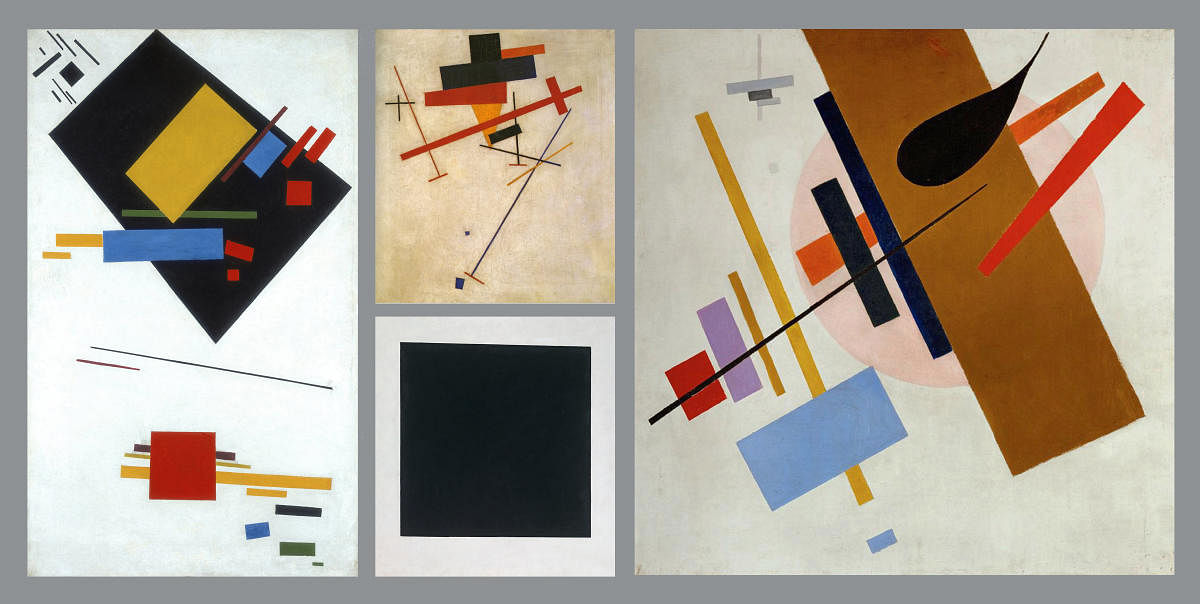
By all accounts, Kasimir Malevich (1879-1935) had an enormous influence on the development of abstract art of the 20th century. In the manifesto, ‘From Cubism to Suprematism: The New Realism in Painting’, which he penned in 1916, Malevich espoused the aesthetic and moral superiority of a new system of abstract art, which was a complete departure from the prevalent pictorial format.
He considered realism to be a distraction from the transcendental understanding and experience that the art was meant to evoke. He even declared that objectivity, in itself, was meaningless; and concepts of the conscious mind were worthless. As an alternative, he proposed a bold visual language in which the emphasis was on pure feelings and sensations.
“Our life is a theatre piece, in which non-objective feeling is portrayed by objective imagery,” wrote Malevich. “An antique temple is not beautiful because it once served as the haven of a certain social order or of the religion associated with it, but rather because its form sprang from a pure feeling for plastic relationships…The Suprematists have deliberately given up objective representation of their surroundings in order to reach the summit of the true ‘unmasked’ art; and from this vantage point, to view life through the prism of pure artistic feeling.”
Few artistic movements were as short-lived and yet left such a lasting legacy, as Suprematism in which the art’s essentials were narrowed down to geometric shapes, stark colours and motifs such as the circle, square and rectangle. Among Malevich’s famous Suprematist paintings, Black Square (1915), is often referred to as a truly iconic work, which caused a sensation among Russian art crowds and resonated with the social upheaval in Russia at that time.
“Malevich was a revolutionary,” wrote Russian author, translator and scholar Rosamund Bartlett. “In Petrograd in 1915, two years before the Bolsheviks stormed the Winter Palace, he exhibited Black Square, the first completely non-representational painting. Even more forcefully than Picasso’s Cubist masterpieces and Kandinsky’s abstract canvases, Black Square turned conventional assumptions about art on their head and became Malevich’s most famous work. Just as Stravinsky’s Rite of Spring, first performed in 1913, came to be seen as the most important musical work of the 20th century, so Malevich’s Black Square is the most important painting of the last century.”
A constellation of geometry
On November 3, 2008, Malevich’s Suprematist Composition sold for $60 million at a Sotheby’s auction making it the most expensive Russian painting ever auctioned. The 35-by-28 inch, oil-on-canvas was described by Sotheby’s as a brilliant constellation of geometry and colour in space. “Indeed, it is the elemental beauty of the natural world that is isolated and exalted in Suprematist Composition.”
Ten years later, on 15 May 2018, the same work came up for sale, this time at Christie’s Impressionist & Modern Art auction. Much to the delight of the auctioneer, it sold for a whopping $85.81 million.
The painting had come a long way since its creation in 1916. It was among the many drawings and paintings Malevich had carried with himself on his trip to Berlin in May 1927.
His two-month stay in the German capital was productive and exciting. Unfortunately, his trip ended abruptly when the Russian authorities refused to extend his visa and forced him to return to Russia. Before departing, Malevich left his paintings with German architect Hugo Häring (who had helped him mount the exhibition in Berlin), hoping that one day he (Malevich) would be able to return to Europe or at least get back his works to Russia.
Malevich’s life took a disastrous turn in his homeland. He fell out of favour with Russian authorities who became suspicious of him as well as the radical artistic ideas he proposed. He was subjected to a brutal smear campaign and was accused of involvement in anti-state activities. His colleagues at the Institute in Leningrad too deserted him, paving the way to his expulsion and forced premature retirement from a teaching career. Under constant surveillance, he lived in distress, poverty and disgrace; and was even arrested for a while. When he died of cancer on 15 May 1935 in Saint Petersburg, the prolific artist and thinker was just 55.
Häring who retained and safeguarded Malevich’s paintings in Germany moved them to his native town of Biberach when Berlin was bombed in 1943. He refused to part with the works and resisted offers from museums declaring that he was only a custodian of Malevich’s works and not the owner.
However, when prolonged illness befell on him, he finally agreed to lend the works to Stedelijk museum, Amsterdam, after signing a contract with it about a year before his death in 1958.
After the fall of the Iron Curtain in the 1990s, the heirs of Malevich approached the Stedelijk museum and the City of Amsterdam demanding custody of Malevich’s paintings. The museum refused and a long legal battle ensued.
Finally, the dispute was resolved in April 2008, when the two parties sealed an understanding. Thus the ‘Suprematist Composition’ (among several others) which had remained for 50 years as part of the museum collection in Amsterdam was released to the artist’s heirs, who, within months of acquiring it, put it on auction at the Sotheby’s.